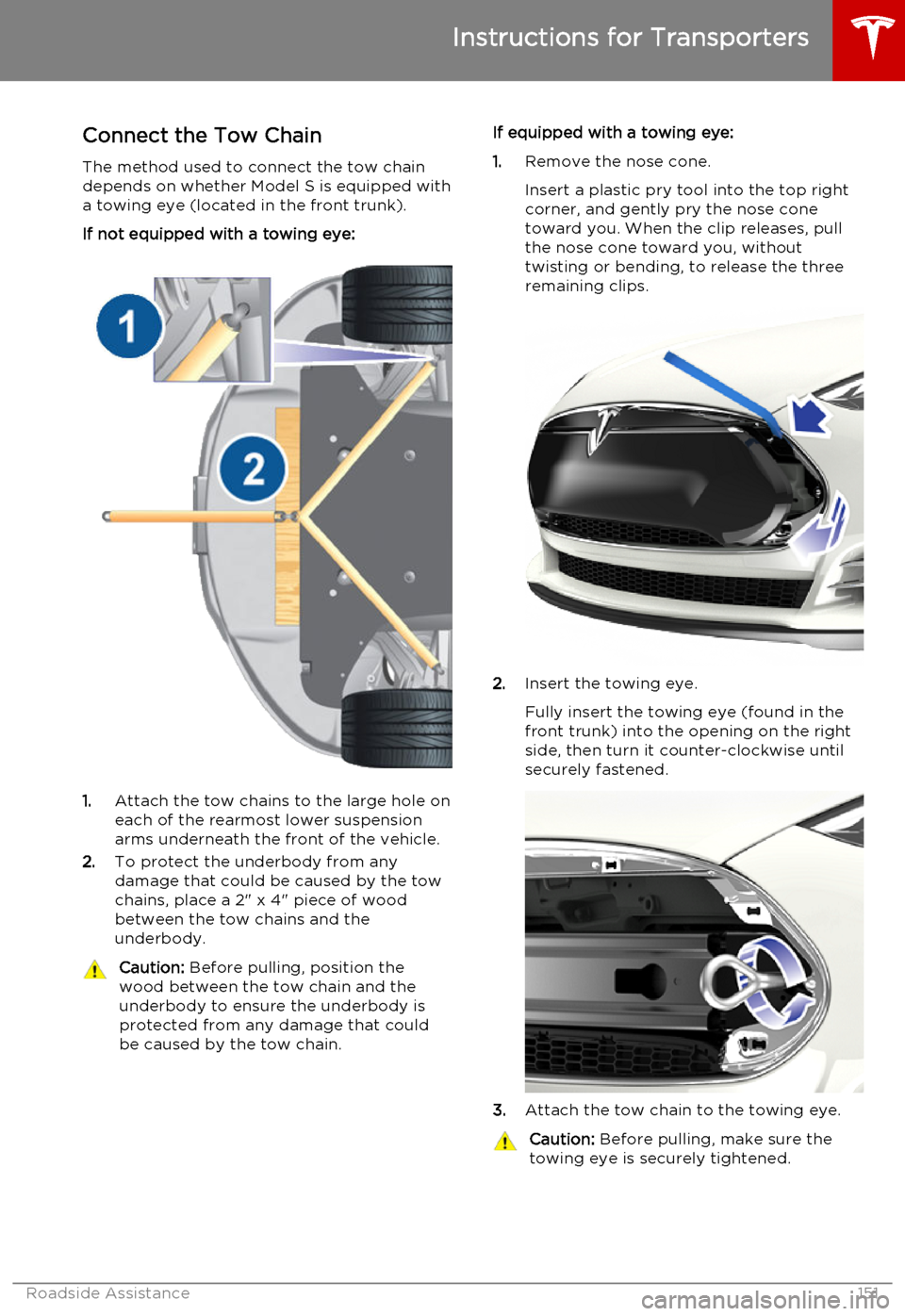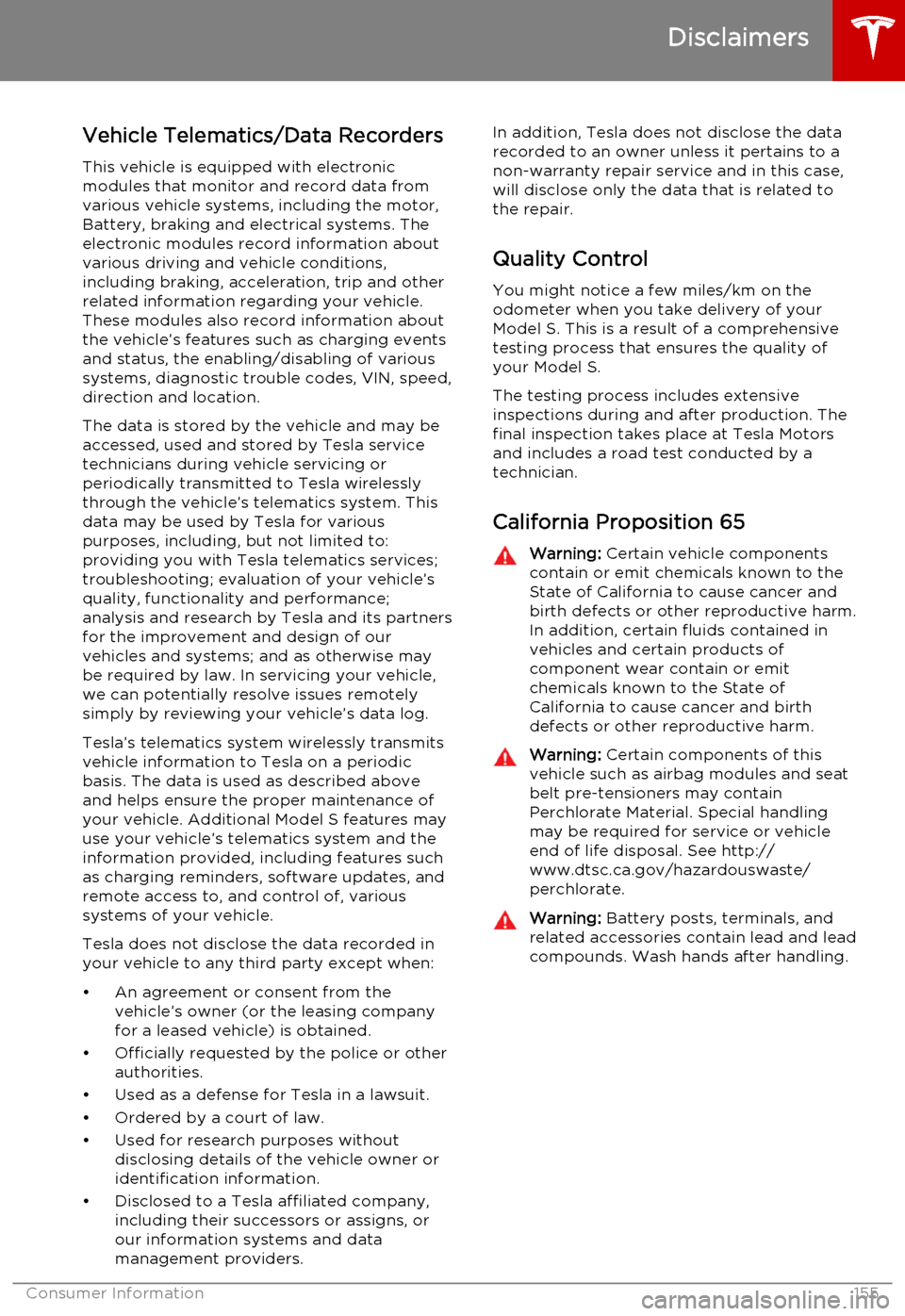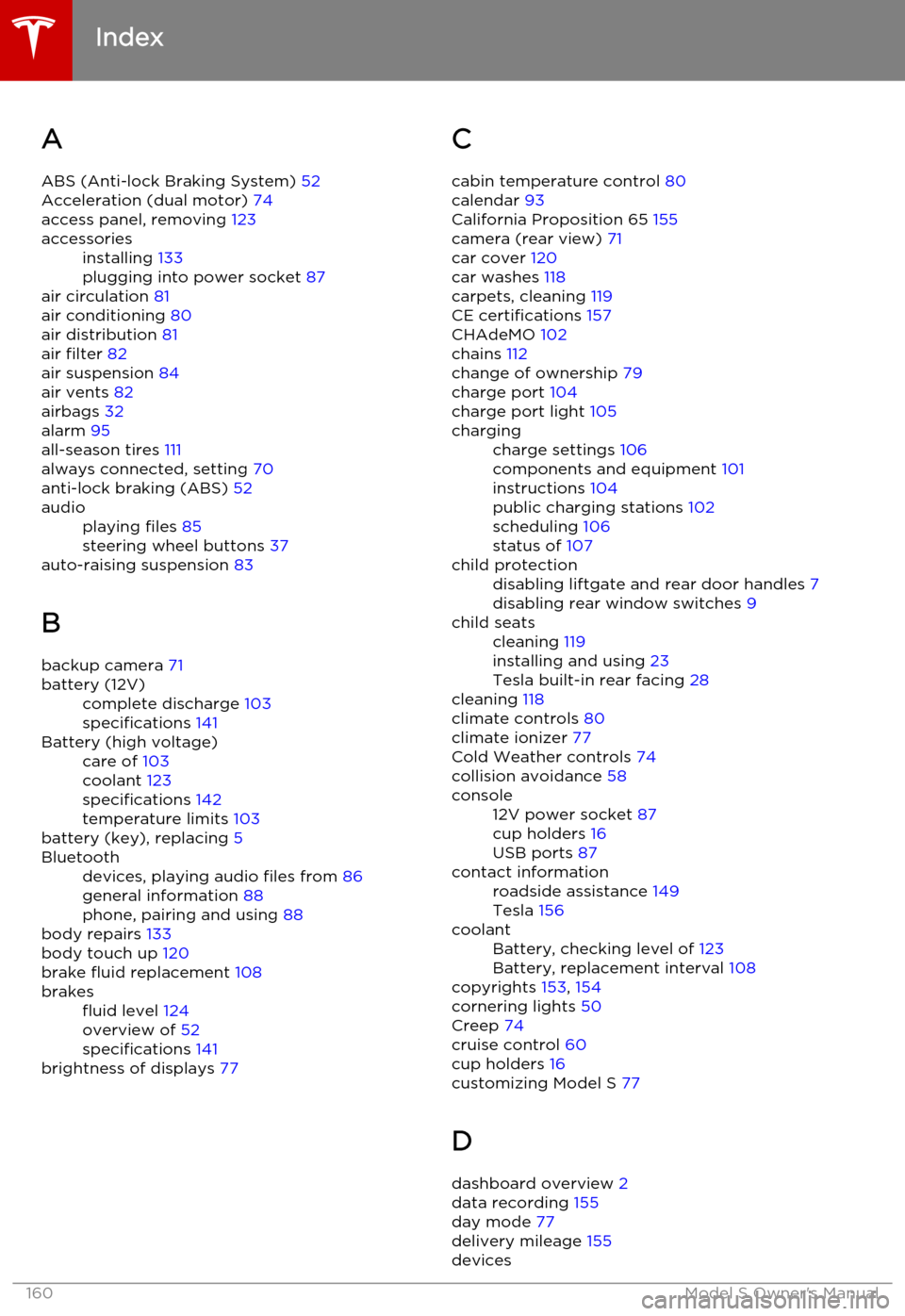TESLA MODEL S 2015 Owner's Manual
Manufacturer: TESLA, Model Year: 2015, Model line: MODEL S, Model: TESLA MODEL S 2015Pages: 164, PDF Size: 4.78 MB
Page 151 of 164

Connect the Tow Chain
The method used to connect the tow chain depends on whether Model S is equipped with
a towing eye (located in the front trunk).
If not equipped with a towing eye:
1. Attach the tow chains to the large hole on
each of the rearmost lower suspension arms underneath the front of the vehicle.
2. To protect the underbody from any
damage that could be caused by the tow
chains, place a 2" x 4" piece of wood
between the tow chains and the
underbody.
Caution: Before pulling, position the
wood between the tow chain and the
underbody to ensure the underbody is protected from any damage that couldbe caused by the tow chain.If equipped with a towing eye:
1. Remove the nose cone.
Insert a plastic pry tool into the top right
corner, and gently pry the nose cone
toward you. When the clip releases, pull
the nose cone toward you, without
twisting or bending, to release the three
remaining clips.
2. Insert the towing eye.
Fully insert the towing eye (found in the
front trunk) into the opening on the right
side, then turn it counter-clockwise until securely fastened.
3. Attach the tow chain to the towing eye.
Caution:
Before pulling, make sure the
towing eye is securely tightened.
Instructions for Transporters
Roadside Assistance151
Page 152 of 164

Pull Onto the Trailer and Secure theWheels
Secure wheels using chocks and tie-down
straps:
• Ensure any metal parts on the tie-down straps do not contact painted surfaces or
the face of the wheels.
• Do not place straps over body panels or through the wheels.Caution: Attaching straps to the chassis,
suspension or other parts of the vehicle's
body may cause damage.Caution: To prevent damage, do not
transport Model S with the tires directly
on the ground.
Instructions for Transporters
152Model S Owner's Manual
Page 153 of 164

Illustrations
Illustrations are provided for demonstration
purposes only. Depending on vehicle options,
software version, region of purchase, and
specific vehicle settings, your Model S may
appear slightly different.
Although the owner information is applicable
to both right-hand drive and left-hand drive
vehicles, many illustrations show only left- hand drive vehicles. However, the essential
information that the illustrations are providing is correct.
Errors or Inaccuracies
All specifications and descriptions are known
to be accurate at time of publishing. However, because continuous improvement is a goal atTesla, we reserve the right to make product
modifications at any time. To communicate any inaccuracies or omissions, or to providegeneral feedback or suggestions regardingthe quality of this owner information, send an
email to:
[email protected]
Location of ComponentsThe owner information may specify the
location of a component as being on the left
or right side of the vehicle. As shown here, left
(1) and right (2) represent the side of the
vehicle when sitting inside Model S in a front-
facing seat.Document Applicability
Owner information is updated on a regular
basis to reflect updates to your Model S. However, in some cases, recently releasedfeatures may not be described. To displayinformation about recently released features,
view the Release Notes on the Model S
touchscreen. Release Notes are displayed on
the touchscreen after a software update, and
can be displayed at any time by touching the
Tesla "T" at the top center of the touchscreen,
then touching the Release Notes link. If information related to how to use the Model S
touchscreen conflicts with information in the
Release Notes, the Release Notes take
precedence.
About this Owner Information
Consumer Information153
Page 154 of 164

Copyrights and Trademarks
All information in this document and all
Model S ®
software is subject to copyright and
other intellectual property rights of Tesla
Motors, Inc. and its licensors. This material may not be modified, reproduced or copied, in
whole or in part, without the prior written permission of Tesla Motors, Inc. and its
licensors. Additional information is available upon request. Tesla uses software created bythe Open Source community. Please visit
Tesla’s Open Source software website at http://www.teslamotors.com/opensource .
The following are trademarks or registered
trademarks of Tesla Motors, Inc. in the United
States and other countries:
All other trademarks contained in this
document are the property of their respective owners and their use herein does not implysponsorship or endorsement of their products
or services. The unauthorized use of any
trademark displayed in this document or on the vehicle is strictly prohibited.
About this Owner Information
154Model S Owner's Manual
Page 155 of 164

Vehicle Telematics/Data Recorders
This vehicle is equipped with electronic
modules that monitor and record data from
various vehicle systems, including the motor, Battery, braking and electrical systems. The
electronic modules record information about
various driving and vehicle conditions,
including braking, acceleration, trip and other
related information regarding your vehicle.
These modules also record information about the vehicle’s features such as charging events
and status, the enabling/disabling of various systems, diagnostic trouble codes, VIN, speed,direction and location.
The data is stored by the vehicle and may be accessed, used and stored by Tesla service
technicians during vehicle servicing or
periodically transmitted to Tesla wirelessly
through the vehicle’s telematics system. This data may be used by Tesla for various
purposes, including, but not limited to:
providing you with Tesla telematics services; troubleshooting; evaluation of your vehicle’s
quality, functionality and performance;
analysis and research by Tesla and its partners
for the improvement and design of our
vehicles and systems; and as otherwise may be required by law. In servicing your vehicle,
we can potentially resolve issues remotely
simply by reviewing your vehicle’s data log.
Tesla’s telematics system wirelessly transmits
vehicle information to Tesla on a periodic
basis. The data is used as described above and helps ensure the proper maintenance of
your vehicle. Additional Model S features may
use your vehicle’s telematics system and the
information provided, including features such
as charging reminders, software updates, and
remote access to, and control of, various
systems of your vehicle.
Tesla does not disclose the data recorded in
your vehicle to any third party except when:
• An agreement or consent from the vehicle’s owner (or the leasing companyfor a leased vehicle) is obtained.
• Officially requested by the police or other authorities.
• Used as a defense for Tesla in a lawsuit. • Ordered by a court of law.
• Used for research purposes without disclosing details of the vehicle owner or
identification information.
• Disclosed to a Tesla affiliated company, including their successors or assigns, or
our information systems and data
management providers.In addition, Tesla does not disclose the data
recorded to an owner unless it pertains to a
non-warranty repair service and in this case,
will disclose only the data that is related to the repair.
Quality Control
You might notice a few miles/km on the
odometer when you take delivery of your Model S. This is a result of a comprehensivetesting process that ensures the quality ofyour Model S.
The testing process includes extensive
inspections during and after production. The final inspection takes place at Tesla Motors
and includes a road test conducted by a
technician.
California Proposition 65Warning: Certain vehicle components
contain or emit chemicals known to the State of California to cause cancer and
birth defects or other reproductive harm.
In addition, certain fluids contained in vehicles and certain products of
component wear contain or emit
chemicals known to the State of
California to cause cancer and birth
defects or other reproductive harm.Warning: Certain components of this
vehicle such as airbag modules and seat
belt pre-tensioners may contain
Perchlorate Material. Special handling
may be required for service or vehicle
end of life disposal. See http://
www.dtsc.ca.gov/hazardouswaste/
perchlorate.Warning: Battery posts, terminals, and
related accessories contain lead and lead
compounds. Wash hands after handling.
Disclaimers
Consumer Information155
Page 156 of 164

Contacting Tesla
For detailed information about your Model S,
go to www.teslamotors.com, click the
MY TESLA link, then enter your login credentials (or sign up to get these
credentials).
If you have any questions or concerns about
your Model S, call 1-877-79TESLA
(1-877 ‑798-3752).
Note: You can also use voice commands to
provide feedback to Tesla. Say "Note", "Report", "Bug note", or "Bug report" followed
by your brief comments. Model S takes a
snapshot of its systems, including screen
captures of the touchscreen and instrument
panel. Tesla periodically reviews these notes
and uses them to continue improving Model S. For details, see Using Voice Commands on
page 38.
Reporting Safety Defects - USIf you believe that Model S has a defect which
could cause a crash or could cause injury or
death, you should immediately inform the
National Highway Traffic Safety
Administration (NHTSA) in addition to notifying Tesla Motors.
If NHTSA receives similar complaints, it may open an investigation. If it finds that a safety
defect exists in a group of vehicles, it may order a recall and remedy campaign.
However, NHTSA cannot become involved in
individual problems between you, your dealer,
or Tesla Motors.
To contact NHTSA, you may call the Vehicle
Safety Hotline toll-free at 1-888-327-4236 (TTY: 1-800-424-9153); go to http://
www.safercar.gov; or write to: Administrator, National Highway Traffic Safety, 1200 New
Jersey Avenue SE., Washington, DC 20590.
You can also obtain other information about
motor vehicle safety from http://
www.safercar.gov.
Reporting Safety Defects - Canada
If you believe that your Model S has a defect
which could cause a crash or could cause injury or death, you should immediatelyinform Transport Canada, in addition tonotifying Tesla. To contact Transport Canada,call their toll-free number: 1-800-333-0510.
Reporting Concerns
156Model S Owner's Manual
Page 157 of 164

Key and Passive Unlocking System
FCC CertificationModel
NumberMfrMHzTested ForA-0749G02Pektron315USA
Canada
The devices listed above comply with Part 15
of the FCC rules. Operation is subject to the
following two conditions:
1. This device may not cause harmful
interference, and
2. This device must accept any interference
received, including interference that may
cause undesired operation.
Changes or modifications not expressly
approved by Tesla could void the user's
authority to operate the equipment.
MIC Certification
Model
NumberMfrMHzTested ForA-0749G04Pektron315Japan
IC Certification
The following device is used in vehicles in
Canada:
• Keyfob Model Number: A-0749G02 (315 MHz)
• Keyfob Manufacturer: Pektron
Per IC 10176A-002, this device complies with
Industry Canada licence-exempt RSS standard(s). Operation is subject to thefollowing two conditions:
1. This device may not cause harmful
interference, and
2. This device must accept any interference
received, including interference that may
cause undesired operation.
CE CertificationModel #MfrMHzTested ForA-0749G01Pektron433Europe
Australia New
Zealand
Singapore Taiwan
MalaysiaA-0749G05Pektron433China
HongKong
The devices listed above comply with CEstandards. Operation is subject to thefollowing two conditions:
1. This device may not cause harmful
interference, and
2. This device must accept any interference
received, including interference that may
cause undesired operation.
Changes or modifications not expressly
approved by Tesla could void the user's authority to operate the equipment.
NCC Certification
• Keyfob Model Numbers: A-0749G01 (433 MHz)
• Keyfob Manufacturer: Pektron
According to NCC low-power radio wave
radiation rate of motor management measures:
Article XII of the type certified by the low
power radio, non-licensed, company, firm or
user is not allowed to change the frequency,
increase the power or change the
characteristics of the original design and
function.
Declarations of Conformity
Consumer Information157
Page 158 of 164

Article XIV: The use of low-power radio-
frequency devices shall not influence aircraft security and interfere with legal
communications; interference phenomenon
discovered over time, should be immediately suspended, and improved to no interference
before use can continue. Legal
communications, referring to the provisions of
the Telecommunications Act of radio communications operations. Low-power radiocommunications shall tolerate radio wave
interference from radiated devices, legal or
industrial, scientific and medical.
Device Approval - Australia
Device Approval - Hong Kong
Device Approval - Japan
Tire Pressure Monitoring System FCC IDs: TZSTPMS201, Z9F-201FS43XIC ID: 11852A-201FS4X
The tire pressure monitoring system (TPMS)
complies with Part 15 of the FCC rules and RSS-210 of Industry Canada. Operation issubject to the following two conditions:
1. This device may not cause harmful
interference, and
2. This device must accept any interference
received, including interference that may
cause undesired operation.
Changes or modifications not expressly
approved by Tesla could void the user's
authority to operate the equipment.
Device Approval - Japan
Media Control Unit
Device Approval - Japan
Device Approval - Australia
Declarations of Conformity
158Model S Owner's Manual
Page 159 of 164

HomeLinkThis device complies with Part 15 of the FCCrules and IC-RSS-210 Industry Canada.
Operation is subject to the following
conditions:
• This device may not cause harmful interference.
• This device must accept any interference received, including interference that may
cause undesired operation.
Any changes or modifications to the device not expressly approved by the manufacturer
or Tesla Motors could void the user’s authority
to operate the equipment.
Radio Frequency Information This equipment has been tested and found to
comply with the limits for a Class B digital
device, pursuant to Part 15 of the FCC Rules.
These limits are designed to provide
reasonable protection against harmful
interference in a residential installation. This
equipment generates, uses and can radiate
radio frequency energy and, if not installed
and used in accordance with the instructions, may cause harmful interference to radio
communications. However, there is no
guarantee that interference will not occur in a
particular installation. If this equipment does cause harmful interference to radio or
television reception, which can be determined
by turning the equipment off and on, the user is encouraged to try to correct the
interference by one or more of the following
measures:
• Reorient or relocate the receiving antenna.
• Increase the separation between the equipment and receiver.
• Connect the equipment into an outlet on a circuit different from that to which the
receiver is connected.
• Consult the dealer or an experienced radio/TV technician for help.
Declarations of Conformity
Consumer Information159
Page 160 of 164

AABS (Anti-lock Braking System) 52
Acceleration (dual motor) 74
access panel, removing 123accessoriesinstalling 133
plugging into power socket 87
air circulation 81
air conditioning 80
air distribution 81
air filter 82
air suspension 84
air vents 82
airbags 32
alarm 95
all-season tires 111
always connected, setting 70
anti-lock braking (ABS) 52
audioplaying files 85
steering wheel buttons 37
auto-raising suspension 83
B
backup camera 71
battery (12V)complete discharge 103
specifications 141Battery (high voltage)care of 103
coolant 123
specifications 142
temperature limits 103
battery (key), replacing 5
Bluetoothdevices, playing audio files from 86
general information 88
phone, pairing and using 88
body repairs 133
body touch up 120
brake fluid replacement 108
brakesfluid level 124
overview of 52
specifications 141
brightness of displays 77
C
cabin temperature control 80
calendar 93
California Proposition 65 155
camera (rear view) 71
car cover 120
car washes 118
carpets, cleaning 119
CE certifications 157
CHAdeMO 102
chains 112
change of ownership 79
charge port 104
charge port light 105chargingcharge settings 106
components and equipment 101
instructions 104
public charging stations 102
scheduling 106
status of 107child protectiondisabling liftgate and rear door handles 7
disabling rear window switches 9child seatscleaning 119
installing and using 23
Tesla built-in rear facing 28
cleaning 118
climate controls 80
climate ionizer 77
Cold Weather controls 74
collision avoidance 58
console12V power socket 87
cup holders 16
USB ports 87contact informationroadside assistance 149
Tesla 156coolantBattery, checking level of 123
Battery, replacement interval 108
copyrights 153, 154
cornering lights 50
Creep 74
cruise control 60
cup holders 16
customizing Model S 77
D dashboard overview 2
data recording 155
day mode 77
delivery mileage 155
devices
Index
160Model S Owner's Manual